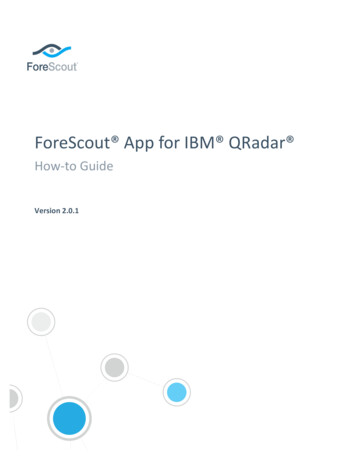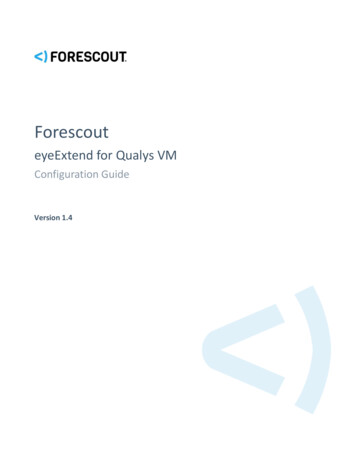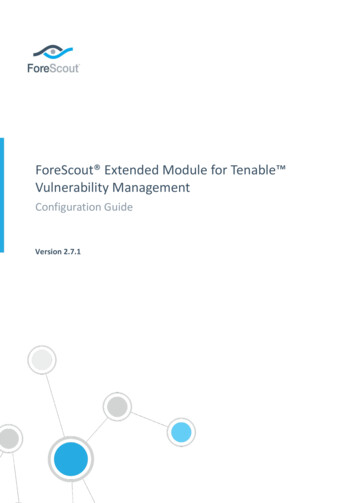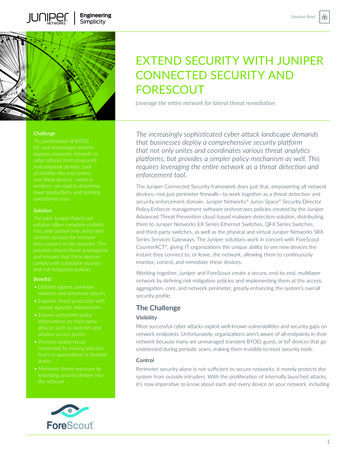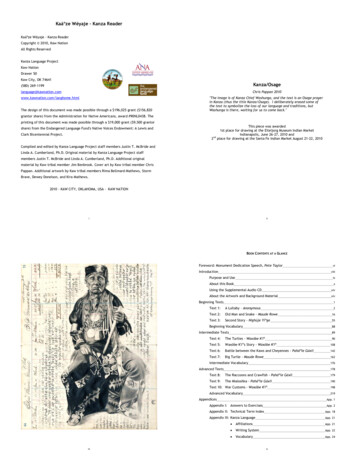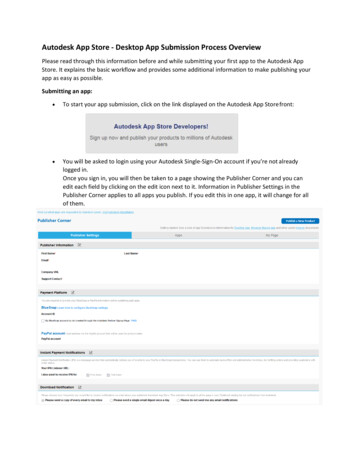
Transcription
ForeScout App for SplunkHow-to GuideVersion 2.0.0
ForeScout App for SplunkTable of ContentsAbout Splunk Integration . 3Use Cases . 3Data Mining and Trend Analysis of CounterACT Data . 4Continuous Posture Tracking Based on a Broad Range of CounterACT Data. 4Response Actions Triggered by Splunk Data Correlation . 4Additional Splunk Documentation . 4About This App . 4Supported Splunk Versions . 5Before You Begin . 5Download and Install the ForeScout App for Splunk . 6Configure the App . 6Configure Splunk Communication with CounterACT . 7Verify and Configure Data Inputs for Syslog Messaging . 8Configure Splunk REST API Credentials for CounterACT . 8Configure a Data Input for Event Collector Messages from CounterACT . 9Working with Dashboards . 10Summary Dashboard . 10CounterACT Policy Dashboard . 11Network Insight and Discovery Dashboard. 12Working with Searches . 13Working with Alerts . 13Targeting Endpoints in Alerts Sent to CounterACT . 14Insert a Search in an Alert . 16Change the Port Used for Alerts . 16Appendix A: Working with CounterACT Data in Splunk . 18About CounterACT Data Events . 18Considerations When Working with CounterACT Events in Splunk . 19Mapping CounterACT Data to the CIM Model . 20Version 2.0.02
ForeScout App for SplunkAbout Splunk IntegrationSplunk Enterprise data analytics help organizations leverage the data that theirinfrastructure and security tools provide, to understand their security posture,pinpoint and investigate risks, and create alerts and reports.However, IT staff must then respond to any identified threats, violations and attacks.Any delay in response can result in significant security risks.Combining ForeScout dynamic endpoint visibility, access and security capabilitieswith Splunk Enterprise’s data mining capabilities, security managers can achieve abroader understanding of their security posture, visualize key control metrics, andrespond more quickly to mitigate a range of security issues.Integration is fully bi-directional – CounterACT sends property, policy, and eventinformation to Splunk, and Splunk sends alerts and notification messages toCounterACT.The result is enhanced threat insight, automated control, and greater operationalefficiency.Use CasesThis section describes important use cases supported by this plugin. To understandhow this plugin helps you achieve these goals, see About This App. Data Mining and Trend Analysis of CounterACT Data Continuous Posture Tracking Based on a Broad Range of CounterACT Data Response Actions Triggered by Splunk Data CorrelationVersion 2.0.03
ForeScout App for SplunkData Mining and Trend Analysis of CounterACT DataSpunk’s strength is storing and indexing data over long periods of time. Tocomplement CounterACT’s real-time monitoring and management tools, Splunkprovides long term data storage and in-depth history and trend analysis tools asstandard options.Continuous Posture Tracking Based on a Broad Range ofCounterACT DataIntegration with Splunk includes a dedicated Splunk app with custom dashboardsthat let security managers quickly monitor the current operational/security posture.With this release, CounterACT reports a wider range of data to Splunk, and thedashboards display real-time metrics derived from this information, such as: Endpoint compliance status summaries Patterns of network access over time Trends in CounterACT policies Significant changes in endpoint processes and applicationsExperienced Splunk users can customize the searches and dashboards provided withthe ForeScout App, or combine CounterACT information with other data sources inthe Splunk environment.Response Actions Triggered by Splunk Data CorrelationThe results of Splunk’s intuitive search and reporting tools can generate notificationmessages which are sent to CounterACT. Based on alert data received from Splunk,CounterACT policies can automatically apply remediation actions, isolate breachedsystems, or invoke additional management steps such as security scans.For example, if Splunk determines that a set of endpoints have a material securityissue, CounterACT can automatically initiate remediation that targets the specificproblem identified by Splunk.Additional Splunk DocumentationRefer to online documentation for more information about the Splunk nkAbout This AppThis app works with the Splunk Plugin to integrate CounterACT and Splunk so thatyou can: Version 2.0.0View data from CounterACT in a dedicated, customizable Splunk dashboard.See Working with Dashboards.4
ForeScout App for SplunkUse Splunk search queries to perform data mining and trend analysis onCounterACT data, and to enrich these searches with data from otherinformation sources. See Working with Searches. In CounterACT, define policies that send CounterACT data to Splunk. Thisdata populates the dashboard and is available to Splunk search tools. Refer tothe Splunk Plugin Configuration Guide.Configure Splunk to send alerts to CounterACT based on custom search orreport results. Searches can combine data from multiple sources. SeeWorking with Alerts. In CounterACT, you can define policies that detect and respond to alerts sentby Splunk. Refer to the Splunk Plugin Configuration Guide.The Splunk Plugin and the ForeScout App for Splunk work together to supportcommunication between CounterACT and Splunk. You must install and configure bothcomponents to work with the features described in this document. For example,CounterACT policies and actions provided by the Splunk Plugin are used to populateSplunk with CounterACT data. Read this document together with the Splunk PluginConfiguration Guide.Supported Splunk VersionsThis release supports Splunk Enterprise version 6.3.x and 6.4.Before You BeginPerform the following steps to work with the dashboard. For steps performed in theCounterACT Console, refer to the Splunk Plugin Configuration Guide.In the CounterACT ConsoleOn the Splunk Server1. Review the Splunk Plugin Configuration Guide and this How-to Guide.2. Choose protocol(s) for CounterACT messaging to Splunk. See Configure the App.3. Verify that CounterACT requirementsare met.4. Install the Splunk Plugin.5. Verify that the Splunk server contains a userwith the required permissions to work withthe ForeScout App.6. Download and Install the ForeScout App forSplunk.Required for configuration:Enterprise Manager IP7. Configure Splunk Communication withCounterACTHTTPS Authorization Token(from Splunk Pluginconfiguration pane)Version 2.0.05
ForeScout App for SplunkIn the CounterACT ConsoleOn the Splunk Server8. Configure Splunk to receive messages fromCounterACT:- Verify and Configure Data Inputs for SyslogMessaging- Configure Splunk REST API Credentials forCounterACT- Configure a Data Input for Event CollectorMessages9. Configure the Splunk Plugin.Required for configuration:Splunk Server IPCustom Port/ProtocolREST API CredentialsEvent Collector AuthorizationToken(from Data Inputs)10. Create a CounterACT policy thatsends information to Splunk.11. Tune the frequency of data reportingbased on your network conditionsand the volume of data you want towork with in Splunk.Download and Install the ForeScout App forSplunk If a Beta version of this release is installed in your environment, uninstall theBeta release before you install this release.To download and install the app:1. Do one of the following: Install the app from Splunkbase at: Download the file SplunkforCounterACT.spl from Splunkbase, or acquireit from your ForeScout representative. In Splunk, select Apps Manageapps install from file. Browse to the app package you downloaded, andupload the package to your Splunk e ForeScout app appears in your Splunk console homepage view, and islisted under the Apps menu.Configure the AppPerform the procedures in this section after the Splunk Plugin is installed inCounterACT and the ForeScout App is installed on the Splunk Server. To completeVersion 2.0.06
ForeScout App for Splunkconfiguration of some of these connections, you must perform parallel configurationsteps in the Splunk plugin. When you first install the app, you are prompted to Configure SplunkCommunication with CounterACT. These settings allow the app to send alertmessages to CounterACT. You must configure the app to receive data from CounterACT. The followingprotocols can be used by CounterACT to send information to Splunk: Using Syslog messaging. To configure the app, see Verify and ConfigureData Inputs for Syslog Messaging. Using one of these HTTP message types:HTTPS messages to the Splunk REST API. To configure the app, seeConfigure Splunk REST API Credentials for CounterACT.Splunk Event Collector messages. To configure the app, see Configure aData Input for Event Collector Messages from CounterACT. The server targets you define in the Splunk Plugin in CounterACT must usethe port, authorization token, and other settings of the data inputs defined onthe Splunk server.Configure Splunk Communication with CounterACTThis procedure lets the ForeScout App for Splunk send alerts to the Splunk Plugin onCounterACT.To configure Splunk communication with CounterACT:1. In the Splunk console window, select Apps Manage apps.2. In the Apps table, find the ForeScout App. In the Actions column, select Setup. The SplunkforCounterACT page appears.3. In the Enterprise Manager Address field, enter the IP address of theEnterprise Manager or standalone CounterACT Appliance in your environment.4. In the Authorization Key field, enter the string in the Alert ServiceAuthorization Token field of the Splunk Plugin configuration pane. Refer tothe Splunk Plugin Configuration Guide for details.Version 2.0.07
ForeScout App for Splunk5. Select Save.Verify and Configure Data Inputs for Syslog MessagingWhen the ForeScout App is installed it automatically creates data inputs for Syslogmessaging from CounterACT. If your implementation uses non-standard ports orother settings, you may need to modify these data inputs.To verify data inputs:1. In the Splunk console, select Settings DATA Data inputs. The DataInputs page appears.2. In the Local Inputs section, select TCP or UDP and locate the data inputwhose Source type is fsctcenter avp. To support Syslog communication, theapp creates TCP and UDP inputs using port 515.3. To modify this default port, clone the data input and modify the port. Verifythat the data input Status is Enabled after modification.Configure Splunk REST API Credentials for CounterACTTo send CounterACT data to Splunk using the Splunk REST API, CounterACT musthave Splunk user account credentials that provide access to the API. Use an existingaccount, or create an account unique to CounterACT.Specify this account’s credentials when you define the REST API source in the SplunkPlugin. Refer to the Splunk Plugin Configuration Guide.Version 2.0.08
ForeScout App for SplunkConfigure a Data Input for Event Collector Messages fromCounterACTWhen you use the proprietary Splunk Event Collector format for HTTPS messagingfrom CounterACT, follow this procedure to create a corresponding Splunk data input.To create a data input for Event Collector messaging:1. In the Splunk console, select Settings DATA Data inputs. The DataInputs page appears.2. In the Local Inputs section, locate the HTTP Event Collector entry. In theActions column, select Add New. The Add Data wizard appears.3. Define a HTTP Event Collector data input with the following settings:Name: ForeScoutSource: CounterACTSource Type: fsctcenter jsonDefault Index: fsctcenter Copy the Token Value and use it to configure HTTP Event Collectorsettings in CounterACT. Refer to the Splunk Plugin Configuration Guide.Version 2.0.09
ForeScout App for SplunkWorking with DashboardsDashboards are powerful tools that let you visualize CounterACT detection processesand management policies, and drill-down to monitor changes in host properties onendpoints. The app provides the following dashboards based on information reportedby CounterACT. Summary Dashboard CounterACT Policy Dashboard Network Insight and Discovery DashboardYou can modify these standard dashboards, or create custom dashboards or graphs.When working with dashboards: Remember that Splunk can only display CounterACT host property and policyinformation that has been sent to Splunk. Define policies in CounterACT thatreport the information you want to work with in Splunk, and tune reportingfrequency to suit your data analysis needs. Hover over the graph to view details and percentages. Hover at the bottom of the graph and select Open in Search to view theSplunk search used to generate the graph.Summary DashboardThe Summary dashboard presents six basic status charts based on endpointproperties reported by CounterACT.Version 2.0.010
ForeScout App for SplunkOnlineThis panel shows the relative frequency of online and offline status during the timeperiod of the chart, for all endpoints within the reporting scope.Connection TrendsThis panel tracks the online or offline status of endpoints within the reporting scopeover time. The graph shows the variation in the total number of endpoints that areonline or offline during the specified time period.ComplianceThis panel displays the results of compliance policies. The graph shows the relativeprevalence of compliant/non-compliant endpoints during the charted period, as apercentage of all endpoints within the reporting scope.Compliance TrendsThis panel tracks the results of compliance policies over time. The graph shows thenumber of endpoints that were compliant or non-compliant over the specified period.Device ClassificationThis panel shows the overall results of endpoint classification policies. The graphshows the relative prevalence of different types of endpoint during the chartedperiod, as a percentage of all endpoints within the reporting scope.Classification TrendsThis panel tracks the results of endpoint classification policies over time. The graphshows changes in the relative number of different endpoint types in the network overthe specified time period.CounterACT Policy DashboardThe Policy dashboard presents charts that track how CounterACT policies evaluateendpoints.The Trends of Policy graph shows how policy rules evaluate endpoints over time.The Rules of Policy pie chart shows how many endpoints matched each rule ofactive CounterACT policies during the specified reporting period.Initially, the graph shows aggregate information for all policies reported to Splunk.Version 2.0.011
ForeScout App for SplunkTypically it is more useful to look at how individual policies evaluate endpoints. Inthe Show Policy drop-down, select a CounterACT policy.Network Insight and Discovery DashboardThe Network Insight and Discovery dashboard tracks changes in a core set ofCounterACT host properties. Use this dashboard to identify anomalous behavior andsignificant changes in the users, processes, applications, and other metricsassociated with endpoints.To use the Network Insight and Discovery dashboard:1. Select the CounterACT host property you wish to view in the DiscoverValues for Property drop-down.2. Use the following drop-down fields to specify search criteria:That firstappear inThe search finds new property values that first occur during the periodspecified in this field. Typically this is the shorter time period specified.DuringperiodThe overall time frame that is searched for new property values.Typically this is the longer time period specified.The dashboard displays values of the selected property that first appearduring the interval specified in That first appear inANDDo not appear before then within the During period.Version 2.0.012
ForeScout App for SplunkThe dashboard can be used to track the following CounterACT host properties: Instant Messaging Running Linux Running Processes MAC Running Processes Network Function Open Ports P2P Running Switch IP Switch Port Name Windows Applications Installed Windows Processes Running Windows Services Installed Windows Services Running WLAN AP NameWorking with SearchesAs a starting point for creating your own searches that include CounterACT data,examine the searches used to generate the dashboards provided with the ForeScoutApp. To examine macros referenced by these searches, selectSettings KNOWLEDGE Advanced search and select Search macros. Not all CounterACT host properties are mapped to the CIM model. SeeMapping CounterACT Data to the CIM Model for details.Working with AlertsThe app provides the following predefined alerts. These alerts are parsed by theSplunk Plugin to populate the Splunk Alerts and Splunk Last Alert hostproperties. CounterACT management policies examine these properties to respond toSplunk alerts.TitleDescriptionquarantine cim host intrusion detectedSends an alert with disposition Quarantine {3} toCounterACT based on a search of CIM typed datatrigger fsnotify webhookSends an alert with disposition Notify {1} toCounterACTtrigger fsblock webhookSends an alert with disposition Block {4}to CounterACTtrigger fscancel webhookSends an alert with disposition Cancel {0} toCounterACTVersion 2.0.013
ForeScout App for SplunkTitleDescriptiontrigger fsother webhookSends an alert with disposition Other {5} toCounterACTtrigger fsquarantine webhookSends an alert with disposition Quarantine {3} toCounterACTtrigger fsremediate webhookSends an alert with disposition Remediate {2} toCounterACTRead this section carefully before you try to use your own searches with these alerts.By default, port 80 is used to send alerts to CounterACT. To use another port foralert messaging, edit the port configured in these predefined alerts as described inChange the Port Used for Alerts.Targeting Endpoints in Alerts Sent toCounterACTThe alert messages sent to CounterACT must reference a specified endpoint.Typically CounterACT acts in response to the message by applying management orremediation actions to the endpoint. The IP address is used to specify the endpoint.This leads to the following considerations:Mapping Search Terms to IP AddressesThe results array contained in the alert message payload must contain a Field:Valuepair that CounterACT can parse to yield an IP address. CounterACT recognizes thefollowing CIM tags as containing IP address information: dest dest host dest ip dest nameIn addition, CounterACT recognizes the label ip although it is not a CIM tag. When IPaddress information is in result fields not recognized by CounterACT, use theVersion 2.0.014
ForeScout App for Splunkfollowing command in your search to label IP information so that CounterACT canparse it:eval ip IP info Where IP info is an expression or field that resolves to an endpoint IP address.CounterACT evaluates the fields in the following order: ip dest ip dest host dest name destThe first IP address found is used to identify the endpoint to which the alert applies.If an endpoint with this IP address does not exist in CounterACT, the alert isdiscarded.Generating an Alert Message for each EndpointTypically a search returns more than one matching endpoint. Splunk must sendthese results to CounterACT as individual messages, each for a single endpoint, likemost host information is reported to CounterACT. The trigger conditions for the alertsprovided all use the Trigger Once For each result logic to ensure that an alertmessage is generated for each endpoint found by the search. It is recommended toretain this logic.The default time expressions are:Earliest -5m@mandCron Expression */5****Combined, these expressions cause Splunk to process alerts at five minute intervals.This approximates real-time alert behavior, while avoiding the processing overheadof real-time alerts.Version 2.0.015
ForeScout App for SplunkInsert a Search in an AlertTypically, Splunk searches are saved directly as Alerts with editable actions. To applythe actions of these predefined alerts to the results of your Splunk search, a differentapproach is required: clone and edit the alert that provides the desired action, andthen paste your search logic into the clone.To insert a search in an alert:1. Compose and test your search. Select and copy the search.2. In the App, select Alerts view.3. Locate the alert that sends the type of message you want. In the Actionscolumn, select Edit Clone. The Clone Alert dialog appears.4. Edit the alert’s name and permissions. Select Clone Alert.5. The Alert has been cloned dialog appears. Select Open in Search.6. Replace your search with the default search of the alert.7. Select Save and save the alert.8. (Optional) By default, port 80 is used to send alerts to CounterACT. If you areusing a port different from the default port, edit this setting in the clone asdescribed in Change the Port Used for Alerts.Change the Port Used for AlertsBy default, port 80 is used to send alerts to CounterACT. To use another port foralert messaging, edit this setting in the predefined alerts provided with this app.To change the port used for alert messaging:1. In the Alerts view, select one of the predefined alerts provided with the app,or a cloned copy.2. Select Edit Edit Actions. The Edit Actions dialog appears.Version 2.0.016
ForeScout App for Splunk3. In the URL field, enter the full URL to the target CounterACT device thataccepts alert notifications from Splunk. The string you enter overridesdefaults used for this messaging, for example:Version 2.0.0 Specify a port in the URL string, using standard /host:port/ syntax. To use secure HTTP, use the https:// prefix in the URL string.17
ForeScout App for SplunkAppendix A: Working with CounterACT Datain SplunkThis section describes the structure of data submitted by CounterACT to Splunk, andhow this influences your use of CounterACT data in Splunk searches.About CounterACT Data EventsCounterACT policies use the Splunk Send Update from CounterACT action toregularly report a selected set of host properties to Splunk.When this action is applied to an endpoint, CounterACT sends event messages with adata payload. Each time this action is applied to an endpoint, several eventmessages may be sent to Splunk: When the Policy status option is selected, CounterACT sends a separateevent message for each policy rule that is reported to Splunk. When the Host Properties option is selected, CounterACT sends a separateevent message for each host property that is reported to Splunk. Similarly,when the Compliance Status option is selected, CounterACT sends an eventmessage with the value of the Compliance Status host property.Each event message contains the following additional information, as field:valuepairs:FieldDescriptionipThe IP address of the endpoint for which information is reported.SinceA timestamp that indicates when the data reported was first detected/resolved byCounterACT. This value is mapped to the time field in Splunk.Version 2.0.018
ForeScout App for SplunkFieldDescriptionctupdateIdentifies the message as a CounterACT update. The value of this attributeindicates the type of data reported by the message: Events that report policy information contain the pair ctupdate:policyinfo. Events that report compliance and host properties contain the pairctupdate:hostinfo. When the Splunk Send Custom Notification action is used, the payloadcontains the pair ctupdate:notif .In addition to standard scheduling and recurrence options, this action provides thefollowing optional triggers for reporting to Splunk: Independent of the policy recheck schedule, CounterACT can send the currentvalue of all information reported by the action to Splunk at regular intervals. CounterACT can send an event message when any property or policy rulereported by the action changes.See the Splunk Plugin Configuration Guide for more details of action configurationoptions.Considerations When Working with CounterACT Events inSplunkConsider the following points when you work with CounterACT event data in Splunk: Because each property and/or policy rule is reported as a separate event,information from the same endpoint must be correlated. This is most easilyachieved using the IP address, which occurs in each event message.In an environment in which IP addresses are frequently reassigned to otherendpoints, it may be possible to use timestamp information to construct asearch that isolates data that was associated with a certain IP addressesduring a specified time period. Timestamps indicate when CounterACT detected/resolved the reported value,not the time of the event message. Applying the Splunk Send Update fromCounterACT action to endpoints does not necessarily cause properties to bere-evaluated. In particular: Any property that was resolved for an endpoint before the action wasapplied to the host is reported with the timestamp of itsdetection/resolution, even though this timestamp predates application ofthe action and creation of the event message. If a previously reported property is now not resolvable by CounterACT, nonew event message is sent to Splunk. If the endpoint was dropped from the scope of the Splunk Send Updateaction, and then returns to the scope, the last known value is reportedagain to Splunk.Version 2.0.019
ForeScout App for SplunkMapping CounterACT Data to the CIM ModelDue to the extensive range of data that can be reported by CounterACT hostproperties, this release of the ForeScout App does not include a Technology Add-onthat fully maps CounterACT properties to tags in the CIM model.The following subset of core properties has been mapped to tags in the CIM model.CounterACT Property(Name and Tag)Splunk TagModelIP Address {ip}dest, dest ipAllWindows Processes Running{process no ext}processApplication StateUser {user}userAllWindows Services Running{service}serviceApplication State /ServicesNetBIO Domain{nbtdomain}dest nt domainMalwareMalicious Event {malic}ids type hostIntrusion DetectionLinux Processes Running{linux process running}Macintosh ProcessesRunning{mac process running}Windows Services Installed{service installed}category, signatureApplianceVersion 2.0.0dvc, dvc ipIntrusion Detection20
ForeScout App for SplunkLegal NoticeCopyright ForeScout Technologies, Inc. 2000-2016. All rights reserved. The copyright andproprietary rights in this document belong to ForeScout Technologies, Inc. ("ForeScout"). It isstrictly forbidden to copy, duplicate, sell, lend or otherwise use this document in any way,shape or form without the prior written consent of ForeScout. All other trademarks used in thisdocument are the property of their respective owners.These products are based on software developed by ForeScout. The products described in thisdocument are protected by U.S. patents #6,363,489, #8,254,286, #8,590,004, #8,639,800and #9,027,079 and may be protected by other U.S. patents and foreign patents.Redistribution and use in source and binary forms are permitted, provided that the abovecopyright notice and this paragraph are duplicated in all such forms and that anydocumentation, advertising materials and other materials related to such distribution and useacknowledge that the software was developed by ForeScout.Unless there is a valid written agreement signed by you and ForeScout that governs the belowForeScout products and services: If you have purchased any ForeScout products, your use of such products is subject toyour acceptance of the terms set forth at http://www.forescout.com/eula/; If you have purchased any ForeScout support service (“ActiveCare”), your use ofActiveCare is subject to your acceptance of the terms set forth and-support-policy/; If you have purchased any ForeScout Professional Services, the provision of suchservices is subject to your acceptance of the terms set forth greement/; If you are evaluating ForeScout’s products, your evaluation is subject to youracceptance of the applicable terms set forth below:-If you have requested a General Availability Product, the terms applicable to youruse of such product are set forth at: http://www.forescout.com/evaluationlicense/.-If you have requested an Early Availability Product, the terms applicable to youruse of such product are set forth at: nt/.-If you have requested a Beta Product, the t
ForeScout App for Splunk Version 2.0.0 5 Use Splunk search queries to perform data mining and trend analysis on CounterACT data, and to enrich these searches with data from other information sources. See Working with Searches. In CounterACT, define policies that send CounterACT data to Splunk. This
